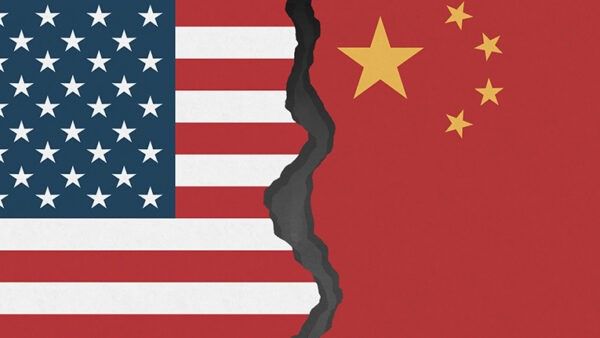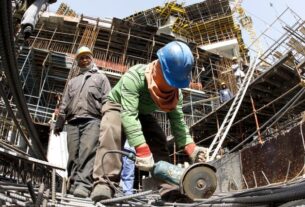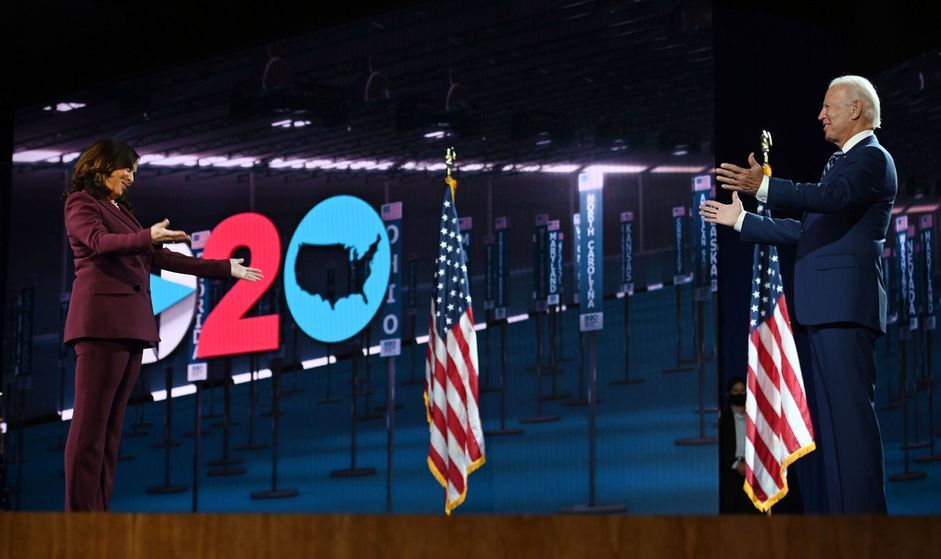Vincent Kolo is a contributor to chinaworker.info.

In July 2018, tariffs were imposed on Chinese imports by President Trump’s government and there was immediate tit-for-tat retaliation by China. This has amounted to the biggest trade war since the 1930s and is increasingly taking its toll on the global economy.
IMF chief Christine Lagarde, reflecting the fears of global capitalism, recently warned that 70 percent of the world economy is expected to see a slowdown in growth over the next two years, urging governments not to aggravate matters with the “self-inflicted” damage of trade wars.
The current Chinese – US negotiations are widely expected to produce a face-saving deal rather than living up to Trump’s rhetoric about a “historic” and “epic” deal not resulting in “structural changes” in China’s economy demanded by the anti-China hawks in the US ruling class.
After nine rounds of talks, Trump’s team are trying to squeeze enough concessions out of China to look like “fundamental changes”. Without this Trump will face accusations of a sell-out from within his own party and from the Democrats. Xi Jinping’s bottom line is that China’s state capitalist economic model is untouchable. Beyond this Beijing can take a flexible approach.
The real roots of this conflict is the battle between China and the US for economic and great power pre-eminence which cannot be negotiated out of existence; that’s not how capitalism and imperialism work. A deal proclaimed as a great victory can be a kind of ceasefire with the conflict shifting from tariffs and trade into decisive fields such as technology, investments, and geopolitics. There is not only a tug-of-war between China and the US but also the EU, India, Russia and Japan, over China’s ‘Belt and Road Initiative’ (BRI) – the biggest global infrastructure project in history.
The pressure for a deal, which is not assured, is the faltering global economy and the political risks of a recession, which could finish Trump’s re-election hopes but could be even more costly for Xi Jinping. There could be unprecedented mass unrest in China in the event of its first recession in living memory.
Both sides dread fresh stock market turmoil. Half the 13 trillion US dollars erased from global markets last year was in the US. Hence the statements about the talks going “very well” and “making progress” designed to boost stock prices and keep the momentum going for more talks. This is indicates how capitalism has become more financialised even than in the run up to the 2008 financial crisis. The policies followed by governments and central banks since then have had a much bigger impact on stock markets than on the real economy. The economic confidence of the capitalists has been restored but rests on precarious foundations.
A new stock market crash could plunge the world economy into recession. Saying that the stock markets have become “too big to fail” is a contradiction in terms.
Trump’s position since the trade war began
Trump has had to pull back partially from a disaster of his own making. In July, when he imposed the first set of tariffs against China, he bragged, “trade wars are easy to win”. The tone was aggressive and provocative but now the US economy is hurting as much as China’s.
The US trade deficit – initially the issue Trump went to war over – grew to an all-time high last year of US$891.3 billion with the whole world and a record US$419.2 billion with China (up 11.6 percent from 2017). These figures are a spectacular refutation of Trump’s “easy to win” bravado.
At the outset Trump’s administration imagined they could achieve quick results. They slapped on an even bigger set of tariffs in September. Trump then threatened that if Beijing retaliated he would extend tariffs to everything China exports to the US. This was heavily influenced by the US midterm elections to Congress with Trump wanting to show he was a tough president. Since then he’s been outflanked by politicians on all sides of Congress who’ve jumped on the anti-China bandwagon.
This complicates the government’s attempts to de-escalate the conflict. Xi realises he needs to make a deal now rather than deal with an even more hard-line US regime in the future.
The risk of things getting much worse in 2019 forced Trump to slow down at his December meeting with Xi Jinping in Buenos Aires, keeping the original tariffs in place but postponing increases due on 1 January. The original deadline was 1 March, but reports now suggest talks can go on “for weeks”, possibly until the Osaka G20 summit at the end of June.
The two sides are not close, but are under pressure to de-escalate, without losing face, causing the negotiations to drag out.
Strategy of Chinese regime in the trade war?
Initially, Beijing was wrong-footed by the tariffs. They thought they could avoid this by offering limited concessions – basically to buy more from the US especially energy and farm produce. They looked at the issue mainly as an economic problem and underestimated the political dimensions on the US side – Trump’s need to show a tough hand. Xi’s regime underestimated how far Trump was prepared to go and the support he had for confronting China.
A year ago, Xi consolidated his dictatorship, abolishing term limits on his rule and increasing state repression to unprecedented levels. There was overconfidence within the ruling group. A domestic backlash against Xi’s authoritarianism was then able to draw some encouragement from the trade war, not in terms of any pro-US sentiment, but rather a feeling of satisfaction that the regime’s all-powerful image had taken a knock. Xi had clearly miscalculated on how to manage relations with the US – China’s single biggest foreign policy issue.
Xi’s people also thought they could count on pressure from Wall Street and China’s “friends” within US finance capital to avert a trade war. US multinationals have been a powerful lobby for greater economic ties with China over several decades. But last year a decisive shift took the Chinese regime by surprise.
Wall Street, which has made mega profits from China and US-led globalisation policies in China, has increasingly adapted to the Trumpian doctrine of demanding more radical concessions and punishing China’s alleged economic “cheating”. This is part of a wider strategic shift within the US ruling class, of which the trade war is just one symptom, towards a fundamentally confrontational approach to prevent China from usurping the dominant position of US imperialism.
In a recent speech, Jamie Dimon, CEO of the largest US bank, J P Morgan Chase, said it was “absolutely right” for the US to enter a trade war with China: “We’re better off dealing with it now, whatever that means for the economy”. When a US banker says this it’s clear there’s been a major shake up in the outlook of the ruling class.
But the nature of this conflict is long-term, with no “easy wins” à la Trump. Xi’s regime is now in no doubt that the ground has shifted in the US-China relationship, that it’s not just a question of an unpredictable US president but rather a historic turning point with the “engagement” policies of the past 40 years giving way to open strategic rivalry. Beijing’s counterstrategy is shifting accordingly.
The concessions China is offering in the latest talks are only a little more substantial than one year ago. They have a bottom line beyond which they won’t go. They know there is big pressure on Trump not to abandon the talks.
This, ironically, explains why Trump walked out of his talks in Vietnam with North Korea’s dictator Kim Jong-un. The two sets of talks are superficially unrelated, but actually Trump’s Korean denuclearisation strategy has always ultimately been about increasing the pressure on China and the struggle for political and military hegemony in the Asia-Pacific. Trump’s walkout was partly to pressure Kim over too little progress, but was also a warning to Beijing that the US side is also prepared to walk away from a trade deal unless more concessions are made.
Remaining obstacles
Both sides will set up “enforcement offices” to make sure they each honour the terms of the deal. Trump’s team need to show their deal is “different” and China will be held to account.
China’s negotiators would not agree to any one-sided enforcement mechanism, as first proposed by the US side, or the idea of current US tariffs remaining in place to ensure Chinese compliance. Both would have been politically unacceptable to China, leaving Xi’s regime open to charges it had accepted “interference in China’s internal affairs” and reviving memories of the “unequal treaties” of pre-revolutionary China.
But the “enforcement offices” seem to be a façade that won’t make much concrete difference. Both governments can impose tariffs against each other, even if these are in breach of WTO [World Trade Organisation] rules – the case with Trump’s current tariffs. The whole deal will probably be in breach of WTO rules, because it is about managed trade rather than “free trade”, showing the WTO is a dying force. US and Chinese “enforcement offices” is are aimed at convincing sceptics in the US Congress that the deal has “teeth” and removing the stigma on the Chinese side of accepting anything that isn’t mutual and reciprocal.
Other potential obstacles to a deal include the US side reportedly drawing up 150 pages of detailed agreements to be signed in six contentious areas: forced technology transfer and cyber theft, intellectual property rights, services, currency, agriculture and non-tariff barriers.
There are reports that the Chinese side has agreed not to use devaluation to counteract the effect of tariffs and to give more information to the US about its currency policies. Actually this is in line with Beijing’s own interests – to broadly maintain the current exchange rate. Beijing is far more concerned about yuan depreciation triggering capital flight than increased exports.
On agriculture, the Chinese have promised huge additional purchases of US farm goods as part of a trade deal. More politically sensitive, and state media have begun preparing domestic opinion for this, Trump’s people are demanding a lowering of Chinese farm tariffs, which potentially could be a heavy blow for many of China’s poor farmers.
Beijing will surely announce subsidies and other support measures, but China’s concessions fall broadly into two categories:- either things the Chinese regime can afford – buying more soybeans and oil from the US will cost countries like Brazil and Iran more than it costs Beijing – or they are vague commitments to “reform” that can be dragged out. That’s a well-honed tactic of the Chinese regime.
But Xi’s regime won’t sacrifice “core areas” – anything vital to their state capitalist economic model – such as state subsidies, protection of key state monopolies and creation of “national champions”. This is not primarily an economic but a political question.
Xi, who represents the billionaire princelings
[hereditary leaders]
within the Chinese regime, state and economy, is fully aware that the regime’s future as a one-party dictatorship rests on its ability to bend the economy – with the “police club” to use Leon Trotsky’s term – to the needs of regime survival and not become a hostage of “the market” as is the case with Western capitalist regimes. Politically, the Chinese side won’t sign up for any deal that looks like caving in to US pressure. They can dress up many of their trade concessions as “reforms” that, while corresponding with US demands, actually came from within China.
A US-China deal
On the economy a deal could give a temporary boost, mainly in terms of financial froth and possibly a new surge on stock markets. Markets, which have soared since the start of the year, have largely priced in a US-China deal. A breakdown in the talks could unleash havoc.
The US, China and other major economies are all slowing in 2019. Parts of Europe are in outright recession. The Chinese regime’s new stimulus measures – the biggest tax cuts in ten years and an explosion of new debt – are having some effect with a partial steadying of the economy. But the effects get smaller and smaller every time with Beijing’s stimulus, while the debt problem gets bigger.
Companies that began relocating their production out of China even before Trump’s tariffs are likely to continue doing so. It is unlikely to coax these companies back to China because the uncertainties mean they want to hedge. They will move factories to Vietnam and other parts of Asia, but in almost no case back to the US.
A trade deal won’t represent a return to the pre-2018 situation. Instead, as economist Stephen Roach says, what is posed is a “protracted struggle” – “cold war 2.0”. Roach also argued that the US economy is in far worse shape – due to higher debt levels and slower growth – to wage a cold war today than it was in the period 1947 to 1991.
Another crucial difference is that in the previous cold war, between a capitalist US and Stalinist USSR, the latter’s state-owned and bureaucratically (mis)managed economy was far less integrated into the global economy than China’s state capitalist economy is today. China is the largest trading partner for 124 countries compared to 76 for the US. There are 120 Chinese companies in the Fortune 500 [the world’s largest companies], just behind the US with 126, and well ahead of Japan with 52 in third place.
Conflicts over the BRI, Huawei and 5G technology, the South China Sea and other territorial disputes, are all likely to worsen. The Global Times [a major regime-controlled newspaper] recognised this when it recently warned, “It is a bad idea to assume that the two sides can sort out their trade matters and then focus on fierce political and security rivalry.” But in reality this is the most probable outcome.
Socialist alternative to trade war and economic nationalism
The escalating conflict between the US and China, and tensions with the EU and other major powers, are symptoms of a chronic condition afflicting global capitalism. The system cannot shake itself free from the crisis that began more than ten years ago.
Governments fear mass upheavals as seen again in the Arab world with the uprisings in Algeria and Sudan against brutal dictatorships. The capitalists are increasingly forced to look for ‘national’ solutions, variants of Trump’s ‘America First’ doctrine. Capitalist globalisation, with its mega profits for the billionaires, has given way to “slowbalisation” as the Economist magazine called it – each capitalist government protecting its own companies and markets and resorting to economic and geopolitical bullying in the sphere of international relations. From 1987 to 2007 world trade averaged 7 percent growth every year, but this slowed to just 3 percent from 2008 to 2014, and has slowed further since then.
For the working class both these phases of capitalist development have resulted in greater exploitation and poverty plus economic, environmental and even military disasters.
The workers’ movement needs an independent approach, refusing to line up behind the economic nationalism of right-wing politicians like Trump or the neo-liberal globalisation policies of liberals but instead demanding policies that strengthen workers’ rights, jobs and the ability to organise freely. We fight for the nationalisation under workers’ control and management of companies that threaten to relocate, close down or outsource production blaming “foreign competition”.
Organisational links need to be built between unions and workers’ organisations internationally. Unions in the US and other countries should demand trade union rights in China, while also fighting to democratise their own unions and turn them into fighting organisations.
International solidarity is needed to support Chinese workers against the Chinese regime’s ban on independent unions and the right to strike. This is the socialist alternative – to stand independently of the capitalists but in united struggle with the working class everywhere, rejecting all capitalist solutions and fighting instead for democratic public ownership and control of the major companies to facilitate democratic planning and socialist trade policies.
This is how to prevent the working class being divided by nationalism and politicians like Trump and Xi which would be the road to defeat.



